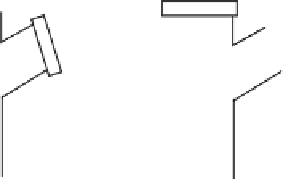Environmental Engineering Reference
In-Depth Information
(1)
(2)
(3)
figure 4.9 Section of bell-and-spigot fillings for clay pipe: (1) wye, (2)
double wye, and (3) tee.
Note:
McGhee (1991) recommends the use of wyes and tees (see Figure
4.9) for joining various sections of wastewater piping. Failure to provide
wyes and tees in common wastewater lines invites builders to break
the pipe to make new connections. Obviously, this practice should be
avoided, because such breaks are seldom properly sealed and can be a
major source of infiltration.
Both vitrified and unglazed clay pipe is made and joined with the
same type of bell-and-spigot joint described earlier. The bell-and-spigot
shape is shown in Figure 4.10. When joining sections of clay pipe, both
ends of the pipe must first be thoroughly cleaned. The small (spigot) end
of the pipe must be centered properly and then seated securely in the
large (bell) end. The bell is then packed with fibrous material (usually
jute) for solid joints, which is tamped down until about 30% of the space
is filled. The joint is then filled with sealing compound. In flexible joint
applications, the sealing elements are made from natural or synthetic
rubber or from a plastic-type material.
Drainage and wastewater collection lines designed for gravity flow
are laid downgrade at an angle, with the bell ends of the pipe pointing
upgrade. The pipe is normally placed in a trench with strong support
members (along its small dimension and not on the bell end). Vitrified
clay pipe can be placed directly into a trench and covered with soil;
however, unglazed clay pipe must be protected against the effects of soil
contaminants and ground moisture.
4.9.1.2 Concrete Pipe
Concrete is another common pipe material and is sometimes used
for sanitary sewers in locations where grades, temperatures, and waste-
water characteristics prevent corrosion (ACPA, 1987). The pipe provides
both high tensile and compressive strength and corrosion resistance.
Concrete pipe is generally found in three basic forms: (1) nonreinforced
concrete pipe; (2) reinforced concrete, cylinder, and noncylinder pipe; and
(3) reinforced and prestressed concrete pressure pipe. With the excep-
tion of reinforced and prestressed pressure pipe, most concrete pipe
is limited to low-pressure applications. Moreover, almost all concrete
piping is used for conveying industrial wastes, wastewater, and storm-
water; similarly, some is used for water service connections. Rubber gas-
kets are used to join sections of many nonreinforced concrete pipe. For









